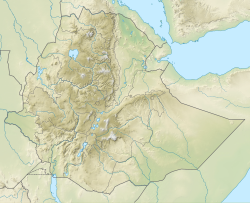Middle Awash
| UNESCO World Heritage Site | |
|---|---|
 Reconstruction of the skull ofAustralopithecus garhi,discovered at the site. | |
| Location | Ethiopia |
| Part of | Lower Valley of the Awash |
| Criteria | Cultural: (ii)(iii)(iv) |
| Reference | 10 |
| Inscription | 1980 (4thSession) |
| Coordinates | 11°6′0.216″N40°34′45.804″E/ 11.10006000°N 40.57939000°E |
TheMiddle Awashis apaleoanthropologicalresearch area[1]in the northwest corner ofGabi Rasuin theAfar Regionalong theAwash RiverinEthiopia'sAfar Depression.It is a unique natural laboratory for the study of human origins and evolution and a number of fossils of the earliesthominins,particularly of theAustralopithecines,as well as some of the oldest knownOlduwanstoneartifacts,have been found at the site—all of lateMiocene,thePliocene,and the very earlyPleistocenetimes, that is, about 5.6 million years ago (mya) to 2.5 mya.[2][3][4]It is broadly thought that the divergence of the lines of the earliesthumans(hominins) and ofchimpanzees(hominids) was completed near the beginning of that time range, or sometime between seven and five mya. However, the larger community of scientists provide several estimates for periods of divergence that imply a greater range for this event,seeCHLCA: human-chimpanzee split.[5][6]
A recent find ofAustralopithecus anamensisis dated to about 4.2 million years ago, which separates it only 200,000 years from an earlier fossil of the more primitiveArdipithecus ramidus(at 4.4 million years ago).Australopithecus garhifossils are dated as recent as the very earlyPleistocene,or 2.5 mya; fossils ofHomo erectusin theDaka memberat the site (at 1 mya) andHomo sapiens idaltu(at 160 ka ago) are found in the middle and late Pleistocene. And patches of fire-bakedclay,disputed as evidences of the controlled use of fire, are also found in that later period.[7]
Sedimentsat the site were originallydepositedin lakes or rivers, andcarbonatesfound there contain lowcarbon isotoperatios. This information suggests that the environment of the Middle Awash was wet during the late Miocene, and that this currently arid region was occupied then bywoodlandor grassy woodland habitats. Fossil remains of othervertebratesfound with the hominins, including thecane rat,further suggest such an environment.[5]The region was the site of periodicvolcanism,which probably created distinctecologicalregions inhabited by different species of vertebrate animals.[8]
Important hominin fossils found in the Middle Awash include:[8][9]
- Ardipithecus kadabba
- Ardipithecus ramidus
- Australopithecus afarensis
- Australopithecus garhi
- Australopithecus anamensis
- Homo erectus
- Homo sapiens idaltufound atHerto Bouri
See also
[edit]- List of fossil sites(with link directory)
- List of hominina (hominid) fossils(with images)
Notes
[edit]- ^"Middle Awash project home".middleawash.berkeley.edu.Retrieved2020-03-02.
- ^"Middle Awash".About.Archived fromthe originalon 2005-10-01.Retrieved2006-04-12.
- ^Kipfer, Barbara Ann (2000) [2000-04-30].Encyclopedic Dictionary of Archaeology.New York, NY: Kluwer Acad./Plenum Publ.ISBN0-306-46158-7.
- ^De Heinzelin, J; Clark, JD; White, T; Hart, W; Renne, P; Woldegabriel, G; Beyene, Y; Vrba, E (1999). "Environment and behavior of 2.5-million-year-old Bouri hominids".Science.284(5414): 625–9.doi:10.1126/science.284.5414.625.PMID10213682.
- ^abHaile-Selassie, Yohannes (2001-07-12). "Late Miocene hominids from the Middle Awash, Ethiopia".Nature.412(6843): 178–181.Bibcode:2001Natur.412..178H.doi:10.1038/35084063.ISSN0028-0836.PMID11449272.S2CID4432082.
- ^Gilbert, W. Henry; Asfaw, Berhane (2008).Homo Erectus: Pleistocene Evidence from the Middle Awash, Ethiopia.University of California Press.ISBN978-0-520-25120-5.
- ^Bogucki (1999) [1999-09-01].Origins of Human Society.Blackwell Publishing.ISBN1-57718-112-3.
- ^ab"Bimodal volcanism and rift basin development in the Middle Awash region, Ethiopia".Archived fromthe originalon 2009-10-04.Retrieved2006-04-12.
- ^Borenstein, Seth."New Fossil Links Up Human Evolution".The Associated Press.Retrieved2006-04-13.[dead link]
References
[edit]- "Middle Awash - Kalaloo Mbr.: Zanclian - Pleistocene, Ethiopia".The Paleobiology Database.Retrieved2006-04-16.

